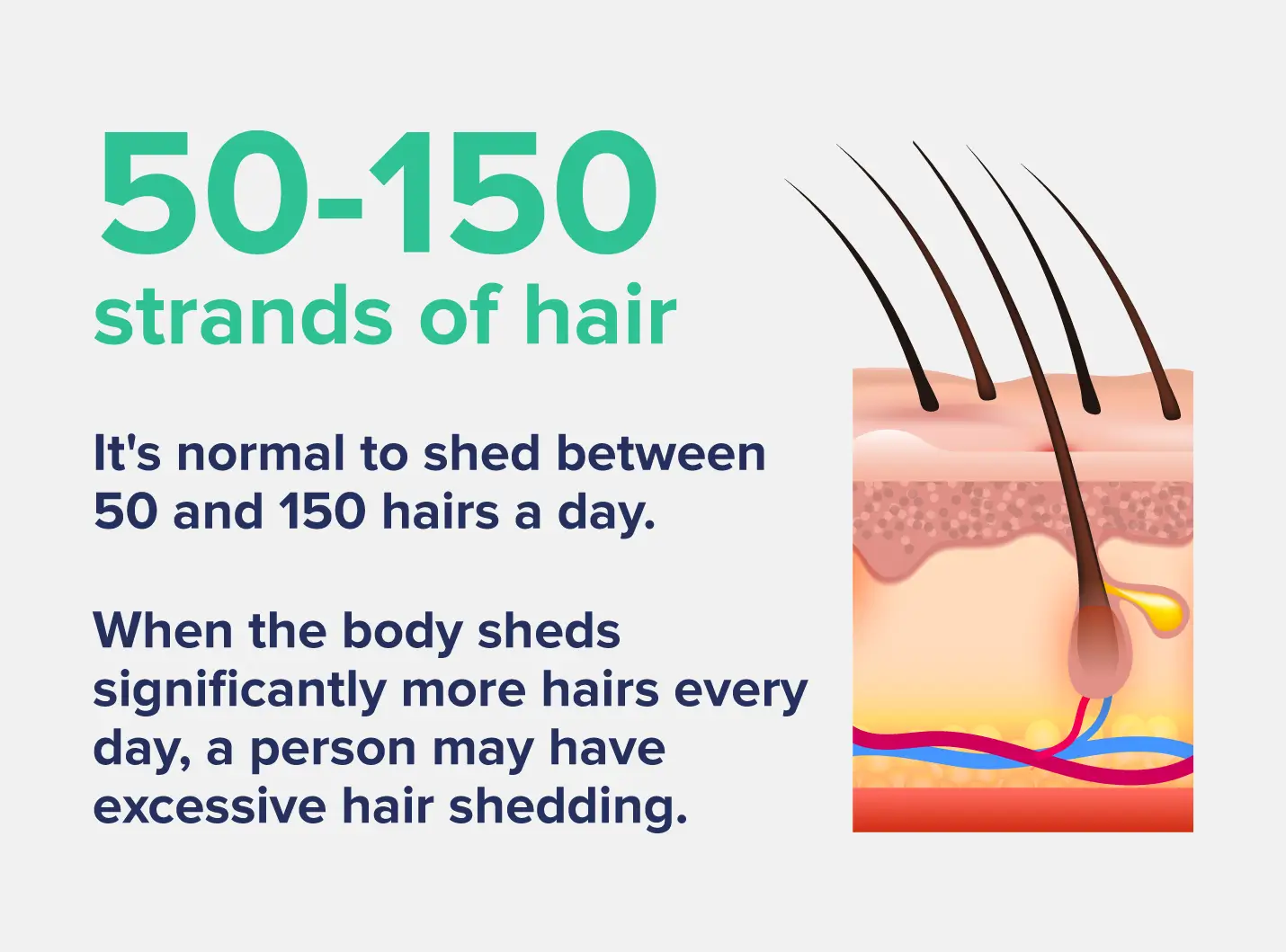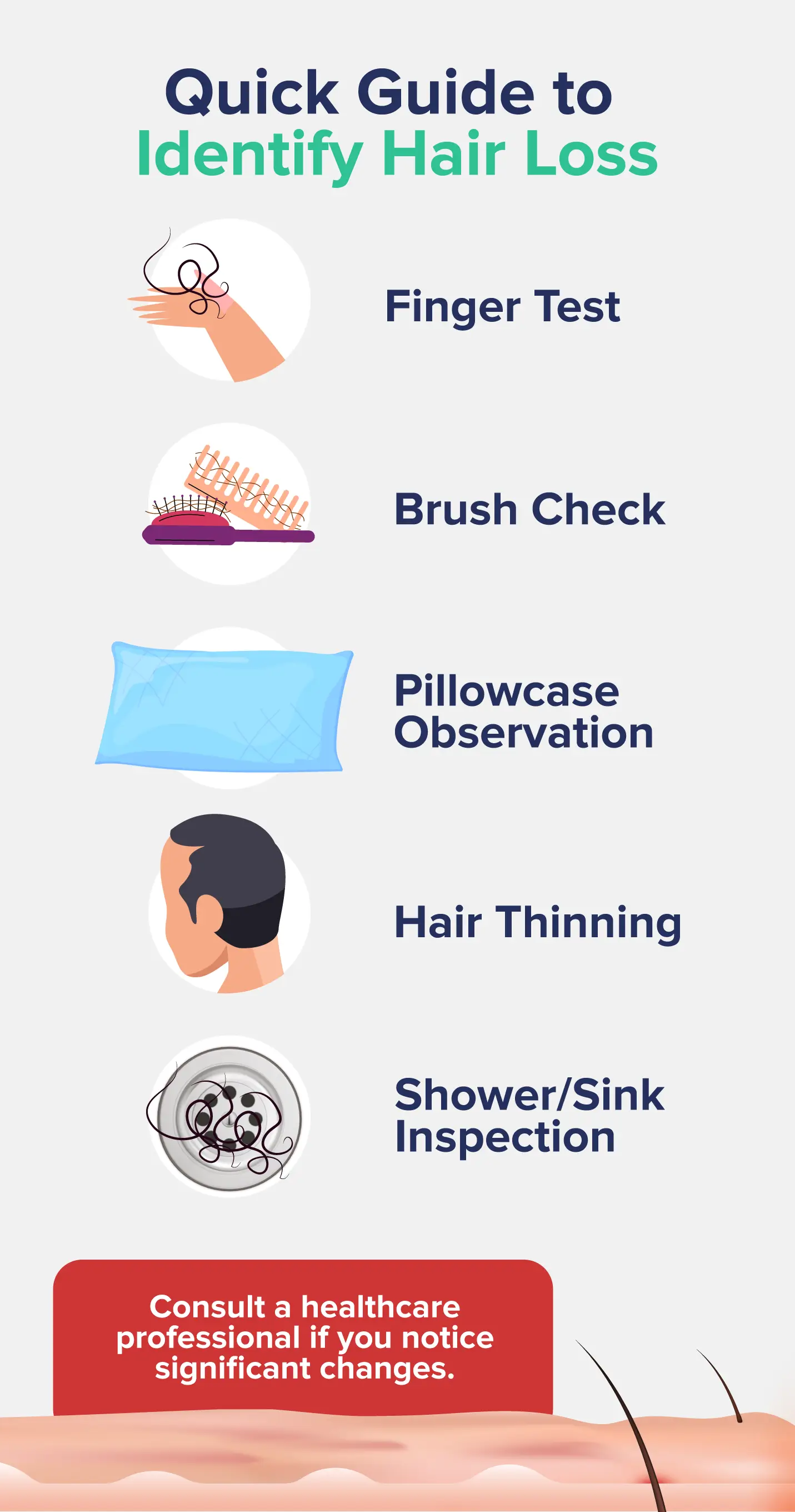Talk to a Registered Dietitian and use INSIDER20 for 20% off!
Talk to a real Dietitian for only $99: Schedule Now
This post contains links through which we may earn a small commission should you make a purchase from a brand. This in no way affects our ability to objectively critique the products and brands we review.
Evidence Based Research To fulfill our commitment to bringing our audience accurate and insightful content, our expert writers and medical reviewers rely on carefully curated research.
Read Our Editorial Policy
It can be alarming to run your fingers through your hair only to find yourself combing out strand after strand of your luscious locks—but are you actually shedding too much hair?
Or is it a normal amount?
While it is true that shedding hair is a normal function of the human body, excess shedding can be an indication of an underlying issue.
Understanding how much hair loss is normal and what could be causing too much of your hair to fall out is essential to keeping tabs on your health and well-being. Here’s what we found.
Losing hair––also called hair shedding––is a natural part of our hair’s life cycle.
In fact, the average person loses around 50 to 150 strands of hair per day.

This is due to the hair growth cycle, which takes place in three stages:
Some parts of our bodies will have different rates at which our hair grows, such as our eyelashes, which have a short cycle (a few weeks). On the other hand, the hair on our head or face can go through a much longer cycle lasting for years.
However, sometimes the hair growth cycle can get disrupted, leading to abnormal levels of hair shedding and, eventually, hair loss.
Hair loss rarely happens overnight, though. So, just like we should regularly feel around our bodies for abnormal lumps and bumps, keeping track of your normal hair shedding rate can help us notice excessive hair shedding if it starts to happen.
Excessive hair loss or shedding can happen to anyone for a variety of reasons––genetics, stress, low-quality hair products, hair styling habits, etc.
Since about 10-15% of our hair is in the telogen (resting/falling out) stage, it might be difficult to recognize when our hair shedding becomes abnormal.

Here are a few ways you can identify abnormal hair shedding:
This is why it’s important to keep a mental note of your hair’s normal fullness, how much hair you typically find when you shower, brush your hair, sleep, or run your hands through your hair.
If you’re experiencing excessive hair shedding, you may experience a gradual thinning which could lead to bald spots and even permanent hair loss.
Before you can address your hair loss, though, you need to figure out the root cause (no pun intended).
When it comes to hair loss, it can be difficult to pinpoint the exact cause since there are so many potential reasons why we can start to lose more hair than normal.
Here are a few of the most common causes of excessive hair shedding and hair loss:
Genetics: Due to genetic factors, male pattern baldness (also known as androgenic alopecia) affects nearly 80% of men by the age of 80. While it most commonly occurs in men with male pattern baldness, women can also experience female pattern baldness. The cause of male and female pattern hair loss is most often due to increased levels of DHT (Dihydrotestosterone), a hormone that influences hair growth in both men and women and prostate growth in males.
Medications: Birth control pills, blood thinners, anabolic (muscle-building) steroids, and even some medications that treat depression can make your hair fall out.
Deficiencies: Nutritional deficiencies due to an unbalanced diet or highly restrictive eating habits can cause hair to become more brittle and lead to thinning of the hair. Extreme weight loss can also cause hair loss.
Disorders and Diseases: Certain medical conditions like thyroid disease, lupus, hormone imbalances, and even fungal infections of the scalp can lead to hair loss.
Stress: Experiencing stressful or traumatic events such as giving birth, having major surgery, experiencing a job loss, or losing a loved one can lead to hair loss due to increases in cortisol levels. This can cause hair to go into what’s called “telogen effluvium,” where many hairs go into the resting stage and fall out. When hair enters telogen effluvium, it can take up to six to nine months for your hair to return to normal.
Hairstyles, Heat Styling, and Treatments: Wearing tight hairstyles (tight ponytails, braids, or even the trendy slicked-back bun) too frequently, as well as extensions and weaves, can cause a type of hair loss called traction alopecia. Harsh treatments with chemicals such as bleach and perming solutions and frequent heat styling can weaken the hair fibers and damage hair, causing breakage and increased hair loss.
Environmental Factors: We can go through a shedding phase with temperature changes (yes, just like your dog or cat does), especially when it gets very warm. If you live in a highly populated area you may also notice increased hair loss due to environmental pollutants and hard water.
While it is unfortunate that hair loss is so prevalent, this does mean there is a greater motivation to find treatments that can stop or even totally reverse hair loss in some cases.
There are hundreds of over-the-counter pills, lotions, and potions on the market that one can take to try and stimulate those hair follicles back into the anagen stage.
Whether or not these products work is really up to the individual since their success is based on anecdotal reports and are not scientifically proven to be effective at preventing, stopping, or reversing hair loss or promoting hair growth.
With that said, many people will try:
Some hair experts online will also recommend scalp massages with one of these scalp massaging brushes which can help stimulate blood flow to the scalp and could increase hair growth.
There is also increasing clinical research being done on microneedling and PRP (platelet-rich plasma) injections, indicating potential for their use in treating androgenic alopecia.
If you’ve tried over-the-counter treatments and you’re still experiencing hair loss or not seeing any improvements in your hair growth, you might try speaking with your doctor about your options.
There are two very common medications often prescribed for androgenic alopecia––minoxidil and finasteride.
Minoxidil is a topical treatment used to slow down hair loss and stimulate hair growth.
Finasteride is one of the most effective treatments for androgenic alopecia, as it blocks the conversion of testosterone into DHT.
However, it can cause some significant side effects (decreased libido, erectile dysfunction, depression) and you may have to take it for many years.
In the last decade or so, the popularity of hair follicle transplants has surged as a more rapid, natural-looking, and permanent treatment for hair loss.
Hair transplant surgery works by taking healthy hair-producing follicles from other areas of your scalp and implanting them (usually) along the hairline or wherever you are experiencing your hair loss.
While this surgery may result in quicker results than if you were to take over-the-counter treatments or prescription medications, it will still take a year for your scalp to heal and the hair to fully grow.
You may also need touch-ups in case some of the follicles fall out and the procedure can be costly depending on where you go.
As we covered previously, not all hair loss is caused by aging or genetics.
If your nutrition is lacking or you’re not eating enough, many of your bodily functions start to not work well.
And it’s not just your hair––sleep quality, weight gain, mental acuity, and skin health are all affected by our diets.
If you’re not doing it already, cutting down on overly processed foods and adding more protein, fresh fruits and vegetables, and complex carbohydrates to your diet is one path to feeling healthier and happier.
While it’s easier said than done––and if you’re fairly certain your hair loss is being caused by stress––you need to try and find a way to remove stress from your life.
If you’re stuck with it, finding ways to cope with the situation, person, or thing causing that stress is the next best thing.
One can do that through therapy, journaling, meditation, breathing exercises, physical exercise, or finding another avenue of stress relief through a hobby.
Making these lifestyle changes won’t just improve your hair health but your overall health, too.
Normal shedding is about 50 to 150 strands of hair a day. Without counting, you can usually tell if you’re losing more than this amount per day.
However, you can also check by running your hands through your hair; if you can pull out more than two or three strands at a time, you may have excess hair shedding. You should also keep a mental note of how much hair you typically find in your hair brush, your shower, the bathroom sink, or on the floor.
If you’re seeing more hairs falling out than normal, it might be time to investigate the source of your hair loss.
If you are noticing large amounts of hair building up on your brush or in your bathroom or after simply running your hand through your hair, this should be cause for concern.
If you are also noticing a visible change in your hair density (it looks thin and lanky) and you are starting to see bald spots form around your scalp, you should contact your doctor or a dermatologist to help identify the cause.
Vitamins in the vitamin B complex are connected to hair production and, subsequently, hair loss. Deficiencies in riboflavin, biotin, folate, and vitamin B12 are all connected to hair loss.
Increased hair shedding in the shower is completely normal. When shampooing and conditioning you are disturbing the hairs in the telegen (resting) stage that were on their way to falling out anyways. Those with curly hair who may not brush their dry hair or have hair fall out throughout the day may find more hair than others when showering, too.